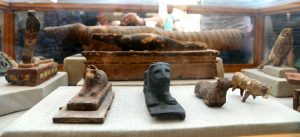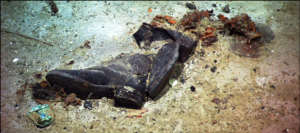For thousands of years, dogs have been seen as man’s best friend, and have been trained and genetically chosen to be of the best use to their human owners. But what about cats? In Egypt, cats are a central component of culture. The first evidence of cats in Egypt dates to approximately 5,000 years ago during the Egyptian Predynastic period (Baldwin 1975:431). There is no proof that these cats were domesticated, but early Egyptians did not discourage the felines from living with them (Baldwin 1975:431). The agricultural lifestyle early Egyptians created meant that rodents were attracted to the farms. Cats flocked to the area, and the humans appreciated the pest control (Baldwin 1975:432). The cats’ hunting skills were valuable to people, so people worked hard to protect the felines. Some people valued the animals so much that they began keeping them as pets (Baldwin 1975:432). The Egyptians valued cats so much that similar to other communities’ burial practices with dogs, they would bury them alongside humans (Baldwin 1975:431). Humans enjoyed the company of cats, and due to their fondness for sun-bathing, they soon became associated with the sun god, Ra (Diesel 2008:79). Now cats weren’t only a pet or a form of pest-control, they also were associated with religion.
It’s important to note that the Egyptians have never viewed cats as being deities. They observed their behavior and created gods and goddesses based off of those observations using the same process that is used for other animals like dogs, snakes, and crocodiles (Wamsley 2018). Many cat-like gods were created, but the most well-known one is Bastet (Figure 1), the cat-headed goddess who is known for being nurturing and fierce, and is associated with the ideas of fertility, domesticity and protection (Diesel 2008:81-82).

Figure 1. A bronze statue representing the goddess Bastet found at a tomb near Saqqara, Egypt. Image: Egyptian Ministry of Antiquities
Cats have been perceived this way for thousands of years, and thousands of them have been mummified and buried in their own cemeteries to reflect their association to the gods and importance to the people around them (Baldwin 1975:434). Archaeologists interested in Egyptian culture find mummified cats often, but a recent discovery at the 4,500-year-old tomb at the Saqqara site just outside of Cairo has led to further discoveries surrounding the importance of animals in Egyptian culture (Wamsley 2018). Dating to the Fifth Dynasty of the Old Kingdom, this newly discovered tomb contained dozens of mummified cats, 100 wooden cat statues (Figure 2) , and a bronze statue of Bastet (Wamsley 2018). The Egyptian Ministry of Antiquities hopes that these artifacts will encourage tourists to learn more about Egyptian history and the role cats have played in shaping Egyptian culture (Wamsley 2018).

Figure 2. One of the wooden cat statues found at the Saqqara site. Image: Egyptian Ministry of Antiquities.
References:
Baldwin, James A.
1975 Notes and Speculations on the Domestication of the Cat in Egypt. Anthropos 70(3/4):428-448.
Diesel, Alleyn
2008 Felines and Female Divinities: The Association of Cats with Goddesses, Ancient and Contemporary. Journal for the Study of Religion 21(1):78-84.
Wamsley, Laurel
2018 Archaeologists Discover Dozens Of Cat Mummies, 100 Cat Statues In Ancient Tomb. https://www.npr.org/2018/11/11/666704847/archaeologists-discover-dozens-of-cat-mummies-100-cat-statues-in-ancient-tomb Accessed 2 November 2019, NPR.
Images:
Figure 1. https://twitter.com/AntiquitiesOf/status/1061274610161868802
Figure 2. https://twitter.com/AntiquitiesOf/status/1061274610161868802
See More:
To see more artistic representations of Egyptian cats and learn about their divine qualities: https://www.npr.org/2017/12/20/570591294/no-kitten-around-museum-exhibit-celebrates-divine-felines
To learn more about why cats have ‘divine energy’: https://science.howstuffworks.com/environmental/earth/archaeology/ancient-egyptians-revered-cats-for-divine-energy.htm


